|
A Look At The Box Art (What
is supposed to be in the box)
This kit review will compare and contrast two 1/72 ‘Braille’
Scale models of the Soviet KV-1 heavy tank of World War 2. Not going
into the detailed history of this significant AFV, I will say that
the features of these two models very well represent those of the
later KV’s and are representative of other KV models released
by PST and Trumpeter; they share many parts. In other words, a lot
of what we know about these two models, on how they compare, goes
for Trumpeter’s and PST’s other KV models.
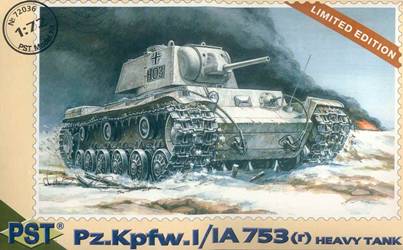
The first thing I noted in PST’s
very nice box art is that it has German markings; the Germans captured
hundreds of KV tanks and put many into use. The Soviet KV-1 was given
the German designation Panzerkampfwagen I/IA 753(r); most references
just refer to it as the PzKpfw 753(r), the (r) indicating a captured
Russian AFV. I have not yet seen a photo of this side of this particular
captured KV-1 so this painting may be mostly speculation by PST’s
artist, but it’s a great painting anyway. This version of the
KV-1 was referred to be the Germans as the KV-1, no year or A or B
designation. PST’s KV was released in the 1990s so is about
10 years older than Trumpeter’s 1/72-scale KV models. This model
is almost the same as PST’s
KV-1 kit #72012 except for additional parts and decals to give
it the features of a captured KV.
The gun and mantlet is of the early, short 76.2-mm L-11 tank gun.,
also used on the T-34 Model 1940 tank. This gun was later replaced
by the higher velocity 76.2 and then 85-mm guns, such as that on the
Trumpeter KV-1 I’ll discuss next. Though we cannot make it out
very well on the turret roof, there is a German PzKpfw IV commander’s
cupola on top of the turret hatch. Also on the turret roof we see
two rotating periscopes at each forward corner.
On the bow, a.k.a. the glacis, we see the driver’s visor in
the center of the glacis plate and to the right is the bow machine
gun; to the left is a single headlight. Two short towing cables come
off the bow cleats to hooks on the fenders. I see one storage box
on the rear of the fender (track guard). The KV is in an overall winter
white camouflage color except for the paint around the vehicle number
H03 which appear to be black letter and numbers edged in white. My
references interpret this underlying color to be German panzer gray
(Dunkelgrau) indicating this KV likely came into German hands before
the winter snow. I have read that this particular tank was used by
the German 1st or the 2nd Panzer regiment during the winter of 1941-42,
but it is sometimes also identified as serving with the 11th Panzer
Regiment of the 6th Panzer Division.

Here is a winter 1941 photo of the real KV-1 and inspiration for PST’s
model, a photo pretty common in several books and websites. This photo
shows the port side while the PST’s box art shows the starboard
side. The German commander’s cupola is clear as is the viewport
and pistol port on the turret side. In addition to tow cables on the
bow there are tow cables attached to the sides and going around the
back of the turret rear. On the starboard side are three storage boxes
which appears atypical to me for a KV, and a German panzer jack at
the front. Some of these early Model 1939 KV-1’s had a pistol
port on the glacis rather than a ball mount machine gun; based on
this photo I cannot be sure how this one is built. The white camouflage
appears clean and well applied; no wear. The roadwheels are the same
as on PST’s model above. For a captured AFV I find the markings
too small and sparse, I would fear mistaken identity and friendly
fire.
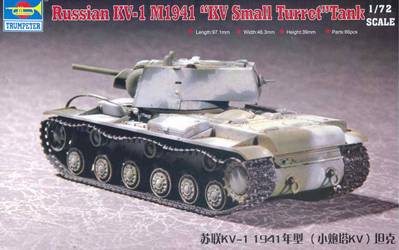
Here we have what Trumpeter offers as a Model 1941 KV-1 “small
turret”. Based on my references this is actually a Model 1940
with F-32 main gun rather than the Model 1941 which has a Zis-5 main
gun. The turret is a welded type and the same type as that in the
PST model. I am unsure why they say “small turret” since
this turret is the same size as other welded KV turrets and is larger
than the cast KV turrets. Instead of the L-11 gun PST gives, the model
has a 76.2-mm F-32 gun and mantlet. On the side of the turret is a
viewport with a pistol port below it. On the rear turret plate is
a machine gun. On the left fenders is a storage box, on the right
fender are two storage boxes. The triangular fender supports should
have triangular holes in them. At the rear of the engine deck is the
curved hood with a curved engine exhaust deflector below. On the left
side of the exhaust deflector is a hole in the deflector with what
I think is a taillight that should be colored red. The sprocket wheel
is in the rear and the idler wheel in the front, like with the T-34
tank and most modern AFVs. The six roadwheels are the same early type
as on the PST model above. The sag of the track appears excessive
to me.
The paint scheme for the model is a patchy white winter pattern over
a light olive green. I don’t see any unit or vehicle markings
or slogans which is not uncommon on Soviet AFVs.
The Kit Parts
The PST kit contains about 95 medium gray color, injection molded
styrene plastic parts with a plethora of additional non-used parts
for different KV models. (These 95 kit parts do not include an entire
sprue of hard link & length styrene track parts.) In the Trumpeter
Models kit there are 61 light gray, injection molded styrene plastic
parts and two soft band tracks and four soft plastic towing cables.
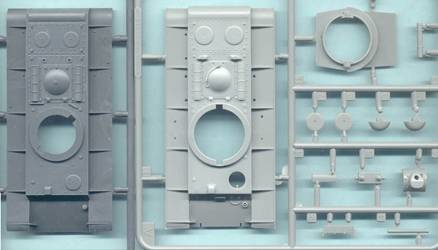
The PST upper hull and fenders
(medium gray color at far left) compares well with Trumpeter’s
light gray upper hull in the center. Some differences include the
sizes of the round engine hatches and the turret ring; what’s
nice is that the Trumpeter kit driver’s hatch can be modeled
open. Trumpeter has the engine exhausts molded onto the engine deck
while PST’s are separate and much better looking. At far right
are Trumpeter’s turret parts, crew hatches, and the F-32 gun
barrel and mantlet; the mantlet could use scribing of the weld seams.
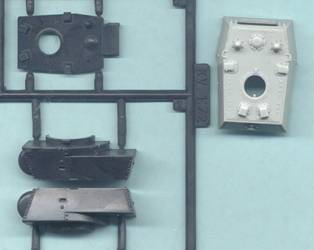
PST’s welded turret is
in three main parts while Trumpeter’s is slide-molded in one
part (not including turret hatches, gun mantlets, and turret base.
To me, Trumpeter’s has overall better detail and accuracy. The
rear of the PST turret will need some filler putty for the seam. Though
the PST model on the box art has the L-11 main gun, the kit actually
contains mantlets for the L-11, for the F-32 and for the Zis-5 76.2-mm
main guns used on the KV-1 tank. On PST’s turret roof you will
need to drill open the four side and rear periscope hoods. The rotating
periscopes in front will need to have view-holes drilled in on both
Trumpeter’s and PST’s models.

PST’s sprue-E contains
parts not only for this Beutepanzer, like the Pz IV cupola at the
right top and bottom, but also the 75-mm KwK40 gun barrel for kit
72027, a 122-mm gun barrel for the KV-9 kit, fuel Jerrycans, and a
Soviet AA machine gun.
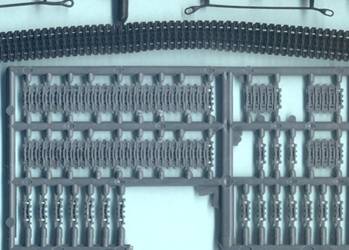
Trumpeter’s soft band
tracks are easy to work with and have great and accurate detail but
are a tad long, something better than being too short. PST’s
hard, styrene link & length tracks are well detailed but I found
that just about every recessed hinge area needed to be filed open
so that the track links would fit together; a lot of work.
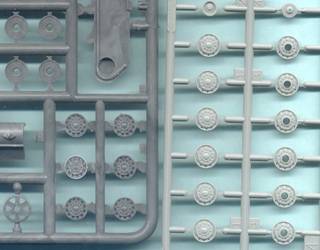
I find that Trumpeter’s
roadwheels (at right) are significantly better molded than PST’s
wheels at left. The backside of PST’s roadwheels are simple
discs which could be a problem when viewing the underside of the model.
The PST roadwheels are molded off-center, something discussed in Doug
Chaltry’s PST KV-1 review.
The Assembly Instructions

PST’s directions give
us painting and markings instructions for three different KV-1’s:
one KV-1 M1939 and two KV-1 M1940’s. The decals applied reasonably
well but some curled and broke, likely due to age.
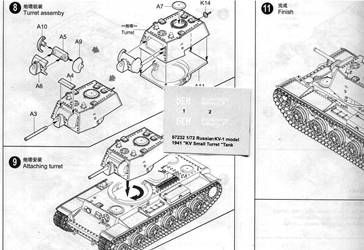
Trumpeter gives water slide decals markings for one KV-1 but with
painting guides for two KV-1 tanks; one KV has no markings. Trumpeter
fails to provide unit information for their KV models; something they
appear to do for all the 1/72 scale AFVs they offer, which is annoying
to me. This page of the Trumpeter instructions is self explanatory
in showing turret assembly.
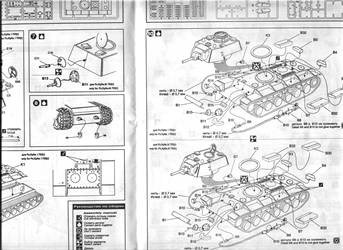
This page from PST’s instructions
final assembly of the turret and hull parts seems a bit complicated
and busy to me.

Trumpeter’s assembly instructions.
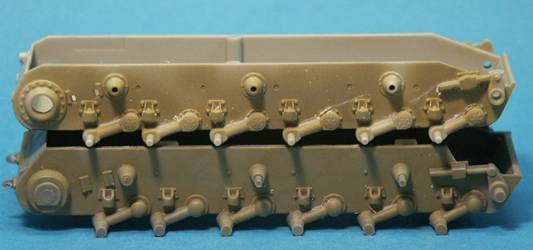
A side-view comparison of Trumpeter’s partially assembled lower
hull on top with that of PST on the bottom. The Trumpeter KV hull
has nicer and more accurate detail. The Trumpeter lower hull is slide-molded
as one piece while the comparable PST lower hull has four parts to
be glued together; this is a reason why Trumpeter has fewer parts
but overall better detail. Both kits come with the torsion-bar arms
and other suspension parts molded on.
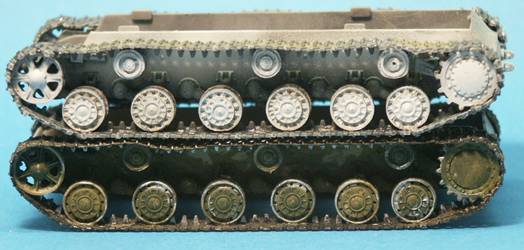
Here we look at the assembled lower hulls again but this time with
the PST hull on the top and with the white paint. When working with
link & length tracks like with the PST model, I advise assembling
the suspension and tracks before gluing the upper and lower hull together.
The PST link & length tracks took much work to assemble straight
around the sprocket and idler and to get realistic sag. The Trumpeter
soft band tracks have good detail but just did not want to adhere
to the wheels with with styrene or super glue. Trumpeter’s sprocket
teeth appear better molded and more accurate. PST’s sprocket
teeth fit poorly into the track links.
Conclusions
Both kits build into very nice representations of early Soviet KV-1
tanks. Due to the wonders of slide molding and more refined engineering
the Trumpeter is generally the better molded and with fewer parts.
A few shortcuts Trumpeter takes, such as with molding the exhaust
pipes onto the engine deck was a bad idea (in my opinion); similar
to molding tools onto the hull rather than offering them separately.
Though the PST molding is about 10-years older than Trumpeter’s,
it builds to a fine model and was released in a dozen variants; unfortunately
PST kits look to be getting harder to acquire.
References
- KV-1 & 2 Heavy Tanks 1939-45,
New Vanguard 17, by Steven Zaloga and Jim Kinnear, and illustrated
by Peter Sarson, Osprey Publishing (1995). Good soft cover book
with history, photos and color drawings.
- Beutepanzer website at (http://beute.narod.ru/)
A great website focusing on captured (Beute) AFVs serving in Axis
armies.
- The Russian Battlefield website:
http://www.battlefield.ru/
- Overall discussion of the KV tank
kits by PST Models by Doug Chaltry http://www.onthewaymodels.com/reviews/PST/KVpreviews.htm
|











